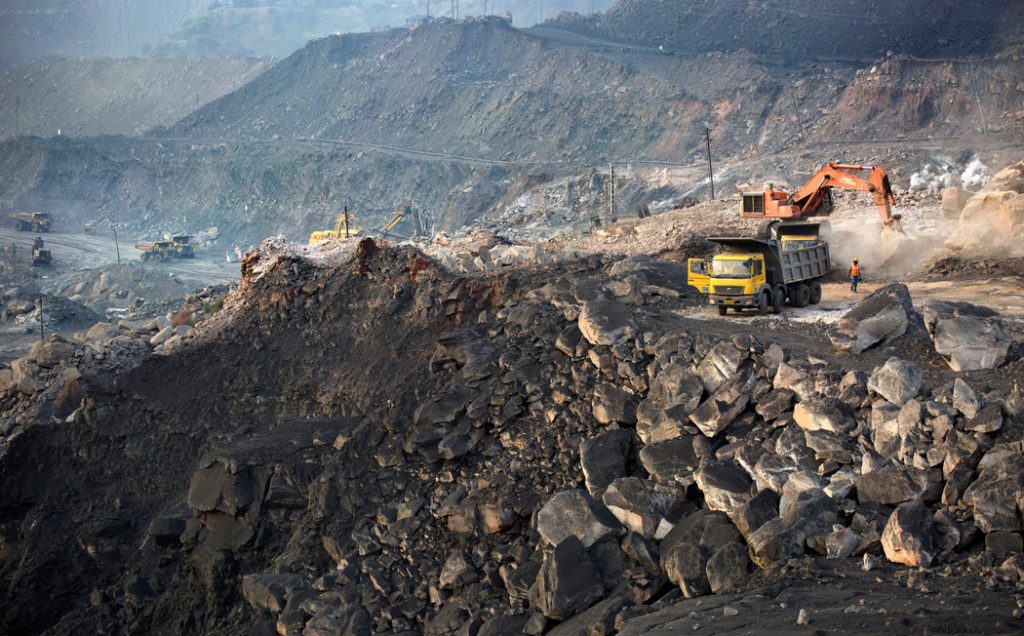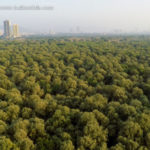IndiaWilds Newsletter Vol. 13 Issue XI
ISSN 2394 – 6946
Stealing the tomorrow of Future Generations
Many years ago, on a warm summer evening, suddenly a few people came running to give the news of a great fire in the forest rapidly moving towards the village. They suggested that the fire can only be contained if all the able bodied men, women as well as children rush to fight the fire. Soon the village folk started offering different opinions.
The farmers said that since they don’t venture into the forest, they are definitely not responsible for setting up the fire. And they had a hard day cultivating their crops, so they will go to sleep as it is nighttime and will think about the fire in the morning. The shepherds said that they only graze their livestock in the grasslands. It is the woodcutters who had indiscriminately cut trees and the logs have now dried up and will easily burn. So, the woodcutters are at fault and should immediately proceed to fight the fire. The shepherds will go early in the morning with their livestock and can help fight the fire at that time. A few youngsters said that instead of fighting the fire, they should abandon their homes and go somewhere else. Why to work so hard to save our home? Let’s find a new home. They even offered their services to carry the luggage of others for a fee. Most of the villagers got divided into groups with each blaming the other and the debate continued for hours. A few realized the danger and decided to fight the fire, but they were too few to be effective. Suddenly the wind picked up and fanned the fire. Soon the fire reached the village and before anyone could respond the raging conflagration burnt down their houses in no time.
Unfortunately, this story is not known to the men and women leading various countries who had landed in Glasgow to participate in the COP26. These Leaders had congregated to discuss steps to save the Planet from climate change. However, they had arrived at Glasgow without some of the essential toolkits. The rich and developed nations had forgotten to carry their wallets. The developing countries asserted that they too have the right to taste the fruits of consumerism and high carbon lifestyle that the developed countries had enjoyed for so long. The island nations and poor countries cried out aloud that climate change is an existential threat and for no fault of theirs they would soon be wiped out. Among all this cacophony, no one could rise to the occasion and display statesmanship.
Two weeks of high-profile negotiations for supposedly urgent climate action passed and the world leaders participating in COP26 arrived at a compromise. There were cheers for achieving it. Unfortunately, what was lost to the leaders is that Compromise by definition is acceptance of standards that are lower than is desirable. The world leaders with their blinkered vision, turned a blind eye to the need of the hour and declared victory by saying that this compromise agreement has many positives and is the best possible.
The world leaders who were at COP26 were focused on their own needs and were not ready to budge an inch from their positions. The developing countries forcefully pointed out that the developed countries have not met their pledge of providing 100 billion dollars a year to help other countries cope up and fight climate change. It is difficult to accurately calculate the actual amount of funds made available by developed countries due to different manner of calculating, and also due to inclusion of efforts made by individuals and private organisations in the final tally.
The developed countries have led a high carbon lifestyle and account for the high amount of historical emission of greenhouse gases. Climate change is known to be caused by such human actions. Hence, the third world countries expect the developed countries to pick up a significant share of the cost of mitigating climate crisis. Unfortunately, the world as we know is not a fair place. In many cases, it is difficult to penalize the guilty as the countries either would not accept their guilt or would renege on their commitments. A case in the point was USA withdrawing from the climate deal when Donald Trump became President of USA. It would be pertinent to mention that the leaders are often a prisoner of their own politics. The previous president of USA belonged to the Republican party, which believes Climate Change is a hoax. The biggest backer of the Republican Party are the Koch brothers who have huge interests in fossil fuels. Thankfully, after a new president was sworn in, USA joined the Climate Agreement once again. Nevertheless, President Joe Biden with only 50 Senate members and a thin majority in the House, is struggling in his efforts to get budgets passed for huge infrastructure investments as well as for fighting the effects of climate change. So, one obviously can’t expect much from USA towards climate change related funding and leadership.
While discussing the climate agreement draft, India and China stood against phasing out coal. The initial phrase of “phaseout of unabated coal and inefficient fossil fuel subsidies” was rephrased to “phase down”. The developing nations latched on to this proposal by India’s environment minister to portray India and China as the ones who put a spanner in achieving a meaningful climate agreement. The role of the developing countries got hidden.
Indian officials say that a hard switch away from coal is not possible without compromising on India’s energy needs. Nevertheless, cynical critics point out that one of the biggest backers of India’s ruling party has huge worldwide interest in coal. And the Chinese have their own sweet interest in holding on to coal. So no wonder, amidst all such conflicting push and pulls, COP26 agreement was perhaps the most tacit acceptance of the fact that the world at large is moving away from the Paris agreement of limiting Earth’s warming to below 1.5 degrees centigrade above preindustrial era levels.
The current extreme weather events like cyclones, floods, sea level rise, heat waves induced by Climate change is a deadly precursor to the apocalyptic turn of events due to higher temperature levels. Most of the world leaders are in their 70s. US President Joe Biden is 78. The President of France in his early 40s is among the youngest. Nevertheless, not many of the current world leaders are expected to be around in 2050, when the Earth’s temperature was earlier hoped to be contained within 1.5 degree celcius of preindustrial levels. These world leaders will not be alive to see the havoc caused by climate change.
If the world leaders care to tap onto the wisdom, then there are lots of wisdom in the ancient civilisations. In the film IP Man 3, the legendary Chinese Martial Arts teacher says
“Life isn’t fair. But that doesn’t mean we can just ignore right and wrong. The rulers may be strong. The subjects may be weak. But the future doesn’t belong to the rich. And it doesn’t belong to the powerful either. It belongs to our children. And perhaps the pure of heart. Have you thought of the children? All the things we do, our children learn from them. We sacrifice. It isn’t fun and it isn’t easy. It’s necessary. Not for Today, but for Tomorrow.”
Who is thinking about tomorrow?
Our generation is caught up in its own thoughts. We have no time for the next generation. Is it good to take away the well being of future generations for our own pleasure? In Vishnu Purana, King Jajati (also pronounced as Yayati) was cursed by Guru of Ashuras, Shukracharya that he will get premature old age. After lot of convincing, Shukracharya relented and said that King Jajati can exchange his old age with one of his sons. However, all the sons refused except the youngest son Puru who readily exchanged his youth with his father’s old age. King Jajati enjoyed all sensual pleasures till wisdom dawned on him about the futility of all this. He then took back his old age and gave back youth to his son. Unfortunately, we in India today don’t have the spiritual ability to turn back the clock and revert back the golden tomorrow that we are stealing from our next generation. We don’t have the sense of right and wrong to understand that stealing the wellbeing of the future generation is not right. If only we Indians look to our Vedas, Upanishads, Puranas and other scriptures; the Chinese tap onto the teachings of Buddha, Tao and others and the Americans the wisdom available with the native Indians, then the spectre of Climate Change can be averted and world can be a better place indeed.
Conservation News:
Air pollution despite 52% reduction in stubble burning shows systemic issues
To curb and abate air pollution from stubble burning, the Commission had prepared a detailed Framework and pursuant to that Action Plans have been finalized by Government of Punjab, NCR State Governments and GNCT of Delhi.
During the current paddy harvesting season, the Commission for Air Quality Management in NCR and Adjoining Areas (CAQM) has been actively monitoring paddy residue burning events for the last one and a half month i.e. from 15th September 2021 onwards in the states of Punjab, Haryana and NCR Districts of Uttar Pradesh & Rajasthan and NCT of Delhi.
Concerted efforts are being taken by the State Governments, Departments and various other Stakeholders towards better in-situ management of crop residue through the use of CRM machinery, PUSA bio-decomposers and facilitating various options for ex-situ utilization of paddy straw, besides large number of IEC activities, educational campaigns, awareness camps and publicity through print, electronic and social media.
As a result of the foregoing report and as per the reports based on the protocol framed by ISRO for the Commission, total active paddy residue burning events in Punjab, Haryana, NCR districts of U.P & Rajasthan and NCT of Delhi have come down from 43,918 in 2020 to 21,364 in 2021 during the period from 15th September to 02nd November i.e. a reduction of 51.35% in the current year compared to the corresponding period of last year.
The week 27th October up till 02nd November has witnessed only 12,853 active cases as against 23,628 cases in 2020, thus exhibiting a reduction of 10,775 cases (about 45.6%)
The major hotspots of paddy residue burning in the state of Punjab are Tarn Taran, Amritsar, Firozpur, Patiala, Ludhiana and Kapurthala. Similarly, the major hotspots in Haryana are Kaithal, Karnal, Kurukshetra, Fatehabad, Ambala and Jind.
8,575 fields where stubble burning was reported, have so far been inspected by the state enforcement agencies and officials of the respective states and Environmental Compensation (EC) of about Rs. 58,05,000 has been imposed.
The Commission is regularly taking up with the State Governments of Punjab, Haryana and Uttar Pradesh to ensure stricter implementation of the Action Plan and the Framework to curb paddy residue burning. Harvesting is on its peak and the State Governments are taking steps as per the Plan of Action to improve the efficacy of enforcement and implementation to effectively tackle the problem of stubble burning.
Stubble burning reduction has no perceptible impact on Air Quality
Unfortunately, despite these efforts to reduce stubble burning, Delhi has witnessed one of the worst air quality ever in November. As a result, the Hon’ble Supreme Court has rightly said that problem lies elsewhere. There is no denying that the stubble burning is impacting the air quality in the National capital region. However, we have failed to look inwards. Though the Delhi state government a few years ago had done odd-even vehicle run in Delhi, the results were not up to expectations. Lots of vehicles including two wheelers and taxis were out of the ambit of that experiment.
In 2020, the complete lockdown due to Covid 19 pandemic had ensured completely clear skies in Delhi during the winter. This clearly shows the impact of traffic movement, construction, industrial activities on the air quality. Everyday there is construction of houses all over NCR region. Single storied houses are converted to four storied. And there are also construction of apartments all around NCR region. People staying in Delhi are even buying apartments as far as 100 kms away from Delhi. The dust from the construction activities gives a massive boost to the smog in Delhi.
There are many small-scale industries all over Delhi. They contribute to the pollution and no systemic study is there to identify and quantify their impact.
Rethink, Reimagine and Reinvent Delhi
The only way smog can be cleaned up is by attacking the root cause of pollution. We need to take steps to decongest the city. Lack of jobs in the smaller towns and cities and lure of making it big in the Capital of India, makes people flock to Delhi. It is important that the Government has to systemically ask industries to move away from Delhi. All large corporates have to move away as well.
The Government of India is a big employer along with the big Public Sector units. There is no need for everyone to there in Delhi. With the advent of internet, lot of work is done online. So only skeletal staff has to remain in Delhi in the Government offices. For that the Government has immediately hire a consultant to reengineer and restructure its offices and mode of working. Unfortunately, the Ministers and the bureaucrats won’t be too happy with that. Unless these steps are taking, Delhi will be a city of Death, as the smog is leading to massive health issues. Air pollution is bringing out genetic changes in kids and teenagers and it is resulting in Telomere shortening ie. ends of the DNA are getting truncated. An estimated 2 million people in India are dying due to air pollution every year. So it is very important that the Government has to wake up and take these steps. Else, Delhi will become a City of Death.
STATEMENT DELIVERED BY BASIC GROUP IN JOINT STOCKTAKE PLENARY AT COP 26
8th November 2021
India takes the floor on behalf of BASIC, comprising of Brazil, South Africa, India and China. We align ourselves with the Statement made by Guinea on behalf of G77 and China.
The BASIC nations thank you and the secretariat for convening this stocktake and the work done so far. We convey assurances of our constructive support for the remaining part of the work in this coming week. We want to flag a continuing challenge that requires your attention. Access to the venue remains challenging, and we feel that the SEC is the least accessible COP venues in recent memory. We request you and the secretariat to make strong efforts to facilitate better access to the venue for party delegates and all COP attendees.
We congratulate you on a very successful WLS. Nations have responded to the ambition gap in mitigation with enhanced NDCs and net zero targets. Pledges and renewed commitments are on the table. We would not like to see the enhanced mitigation ambition meet the same fate as the pre 2020 climate finance ambition. It has been over a decade since the annual USD 100 billion pledge, and the world is still waiting for its mobilization and delivery.
Trust in multilateralism and credibility of the process is at stake. Post 2020 mitigation ambition and net zero pledges require significantly enhanced climate finance. The exact magnitude of the new finance goal can be determined through a structured process, with clear timelines and milestones so that we have a new finance goal well before 2025. It is a simple ask from many developing country parties. Yet, what we are getting is more workshops and in session seminars to discuss the new goal. BASIC would like to warn that lack of a serious approach to climate finance will jeopardize the enhanced mitigation and adaptation ambition as well as net zero pledges of parties. In the interest of transparency and enhanced understanding, we also call for a mandate to SCF to work towards multilaterally agreed, operational definition of climate finance. BASIC nations would also like to stress that the responsibility for climate finance, as mentioned in the convention and PA, should be respected. The CF responsibility remains that of developed countries, towards developing countries.
We support strong, credible domestic mitigation actions by developed country parties without undue reliance on cheap offsets to maintain their high carbon, unsustainable lifestyles. Towards this end, we support markets that are credible and have high environmental integrity and strong non market approaches as well. We hope to achieve agreement on issues of smooth transition of CDM, corresponding adjustments and share of proceeds for adaptation fund.
Adaptation discussions will benefit from operationalization of the Global Goal on Adaptation and the Santiago Network for L&D and finding ways of capitalizing the AF, in view of the importance of securing a predictable source of funding for adaptation.
On ETF, we want to flag that developing country parties require adequate, continued, and assured financial support from GEF, for reporting in the new tables and formats. The ETF discussions cannot be successful without a clear guidance from COP to GEF in this regard .
Finally, cover decisions of COP26 should remain within the confines of the UNFCCC and the Paris Agreement and be fully consistent with its guiding principles of equity and CBDR and RC. The planet will benefit from strong implementation of the PA , particularly in this critical decade . We can shift focus to implementation if we stop renegotiating elements of PA , such as who bears responsibility for providing resources, or how frequently parties need to review their NDCs. These are settled issues under the PA.
In the end, we thank you for sharing your approach to organization of work in week two. You have our support.
Thank You.
India says it speaks on climate change from a position of strength & responsibility
6th November, 2021
During the 11th Facilitative Sharing of Views (FSV) at the COP26 in Glasgow, India made a presentation on its third Biennial Update Report (BUR) that was submitted to UNFCCC in February 2021.
Making a statement on behalf of India, Dr. J R Bhatt,Scientist G(Adviser) in the Ministry of Environment,Forest and Climate Change,highlighted the fact that India represents 17% of the global population, its historical cumulative emissions are only 4%, while current annual GHG emissions are only about 5%.
Following is the full statement of India at FSV Session, 06th November 2021
- We welcome this opportunity to interact with the Parties in this valuable stage of the FSV process for India’s Third BUR. India holds multilateral process in high esteem. India takes its responsibilities and commitments under the multilateral process with utmost seriousness. It is in this perspective that we have prepared an exhaustive BUR.
- BUR3 was particularly challenging as an important part of it was conducted and finalized during the COVID19 pandemic. Nevertheless, India held steady to its commitment on BUR3, as indeed it did for all its other commitments to climate change mitigation and adaptation actions.
- Despite having more than 17% of the global population, India’s historical emissions (~ 4% over 1850 to 2017) and current annual GHG emissions (~ 5%) remain very low.
- India’s per capita GHG emissions (including LULUCF) in 2016, based on the national inventory reported in Chapter 2, were 1.96 t CO2e which is less than one third of the world’s per capita GHG emissions (6.55 t CO2e) (CAIT database, 2020) for the same year.
- We emphasize that India is particularly vulnerable to climate change, a point which many friends overlook in their eagerness to understand our mitigation efforts.
- To follow a sustainable path to development, India has taken several mitigation actions. There is no sector that has been left untouched while planning and implementing climate mitigation actions. They span across the entire economy and society.
- In the last 7 years, India’s installed solar energy capacity has increased 17 times, and stands at about 46 GW as on date.
- India has progressively continued decoupling of economic growth from greenhouse gas emissions. India’s emission intensity of gross domestic product (GDP) has reduced by 24 % between 2005 and 2016.
- India has also proactively contributed to multilateral efforts to combat climate change. Apart from resolutely addressing climate change domestically, for the world, we have created and continue to nurture International Solar Alliance (ISA) and Coalition for Disaster Resilient Infrastructure (CDRI). We are also taking the lead with Sweden in innovation for hard to abate sectors with a view to promoting voluntary action for low carbon transition. We are consciously pursuing our National Hydrogen Mission. So, when India speaks on climate change, it does so from a position of strength and responsibility.
- India is a megadiverse country, supporting four biodiversity hotspots of the world, and our forests are providing all the four ecosystem services.
- India’s 15% of total carbon dioxide emission in 2016 was removed from the atmosphere by the LULUCF. Between 2015 and 2019, the forest and tree cover increased by 13,031 km2 and mangrove cover increased by 235 km2. Populations of Asiatic lion, elephant, rhino increased many folds in last 5 to 6 years.
- India has been riding the tier ladder in inventory estimation and around 2/3rd of our emissions are estimated using higher tiers and also deploy 2006 guidelines.
- Our MRV system is evolving. The operational design of measurement, reporting and verification in India is implemented in a decentralized manner. Efforts are distributed at multiple levels of governance – This is an appropriate strategy for a vast and diverse nation. Many schemes are transparently tracked through online web-portals and digital dashboards.
- Capacity building needs remain a great challenge. India looks forward to climate finance and technology transfer for the expansion in scale and scope of its mitigation and adaptation activities.
- India received 58 questions from the team of technical experts in the ICA
- process and 24 questions from seven countries through FSV portal during the window open for parties to ask written questions. All these had been duly replied and uploaded on FSV portal before the due date of 31st October 2021.
Thank you one and all for your patient hearing.
The United States of America becomes the 101st member country of the International Solar Alliance
In a big boost to accelerate global adoption of solar energy, John Kerry, U.S. Special Presidential Envoy for Climate announced at the UNFCCC COP26 today that the United States of America (USA) has joined the International Solar Alliance (ISA) as a member country. U.S becomes the 101st country to sign the framework agreement of the ISA to catalyze global energy transition through a solar-led approach.
The ISA (International Solar Alliance) is an inter-governmental treaty-based international organization with a global mandate to catalyze global solar growth by helping to reduce the cost of financing and technology for solar. In fulfilling this mandate, the ISA is committed to establishing solar as a shared solution that simultaneously addresses climate, energy, and economic priorities across geographies, facilitating Energy Transition at a global level, Energy Security at national levels, while also ensuring Energy Access at the local level. The ISA is helping large nations scale global commitments, thereby serving the planet’s needs for reduced carbon emissions, while also helping economically more vulnerable nations establish a self-sustaining energy alternative that reduces trade dependency and drives job creation. Universal, affordable, and reliable last- mile electricity connectivity across socio-economic strata is a crucial pillar and targeted, tangible outcome of these combined efforts towards facilitating economic development and environmental impact…
For more details click the below link-
Equipment Discussions:
Sony Unveils 8.6K VENICE 2 Cinema Camera
DJI launches Mavic 3 drone with dual cameras
Natural History
COUNTRY NOTEBOOK: M. Krishnan: ‘W-A-A-K‘ shared By Saktipada Panigrahi
https://www.indiawilds.com/forums/showthread.php?8852-Country-notebook-m-krishnan&p=58667#post58667
TEDx Talk: Learning from India’s Wilds
A recent TEDx talk by Sabyasachi Patra explores the strategies wildlife use in their life and death battles. These learnings can help we humans in improving our lives.
Photography Tips – Learning Exposure
To make photography learning easier, we are creating a photography tutorial video series. The first part of photography tips is on learning exposure. Check it out in this link: https://youtu.be/PT3vvNIJx1g
Wildlife Photography
Elephant from Corbett by Sabyasachi Patra
https://www.indiawilds.com/forums/showthread.php?20067-Elephant-from-Corbett
Leopards by Shyamala Kumar
https://www.indiawilds.com/forums/showthread.php?20058-The-two-Leopards
Yellow-throated Marten by Samrat Sarkar
https://www.indiawilds.com/forums/showthread.php?20050-Gaur-Gavi!
Oriental-Darter by Mrudul Godbole
https://www.indiawilds.com/forums/showthread.php?20051-Oriental-Darter
Scaly-Thrush by Murugan Anantharaman
https://www.indiawilds.com/forums/showthread.php?20056-Scaly-Thrush
BiColoured Leafcutter by Prajwal Ullal
https://www.indiawilds.com/forums/showthread.php?20066-Resting-time
Spare a Thought
This is the 155th issue of IndiaWilds newsletter. An image of a purple heron adorns the cover page of this issue. There was a time when these purple herons were visible in our ponds and lakes adjoining our forests. Unfortunately, due to the explosion of human population we have converted most of our ponds, lakes and other water bodies to construct our houses and industries. There are also not many trees left around our ponds and lakes, so these large birds are hardly seen in and around our villages. Today we are forced to visit large lakes and protected areas to view these beautiful birds.
Apart from the pleasure that we used to derive watching these big and colourful birds, the vanishing ponds, lakes and other wetlands create a bigger problem for the human race. Our bogs and peats and other wetlands capture a lot of carbon. When we drain and dry those, a lot of carbon is released to our atmosphere and adds up to increase the intensity of Climate Change. Extreme weather events like cyclones, floods as well as heat waves and droughts are caused by Climate change. On one hand we are dumping debris on our fresh water bodies and converting those to concrete structures, we are also dumping sewage and industrial waste on our lakes and rivers. So we are polluting as well as depleting our fresh water sources without realising that civilisations have fallen due to lack of water. We humans simply can’t live without water.
The day we understand that our well being is linked with our natural ecosystems remaining healthy, perhaps then we will start reversing the rapidly unfolding climate crisis. Hope we realise sooner, else it may be too late to heal the Planet Earth.
Touche.
I look forward to your inputs and support in preserving the last tracts of wilderness and wildlife left in our beautiful country and raising awareness about it. For other interesting articles and images check –
http://www.indi
To post in the IndiaWilds forums, you can register free of cost using your Full Name as user id at:
http://www.indiawilds.com/forums/register.php
If you are already a member of IndiaWilds and have forgotten your user id and/or password you can mail to:
administrator@indiawilds.com
Regards,
Sabyasachi Patra
Profile | Contact Us | Facebook | Diary | Equipment reviews | Forums | IndiaWilds You Tube Channel
Please post your views and feedback in the comments below.
- Endangered Wild Buffalo of Kaziranga - 4 July,2024
- Leopards: The Last Stand Trailer 2 - 1 July,2024
- GoPro Hero 12 Black - 6 September,2023













Leave a Reply